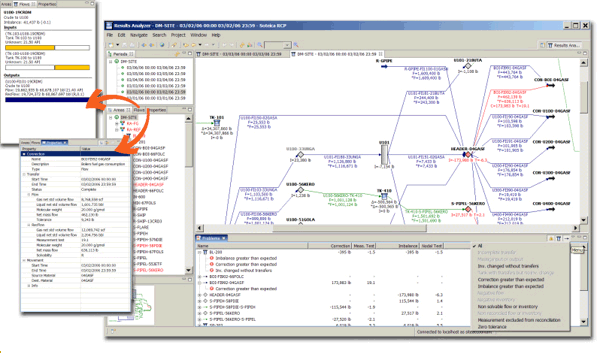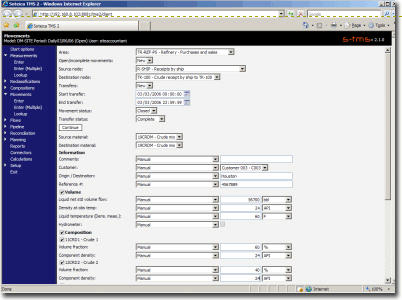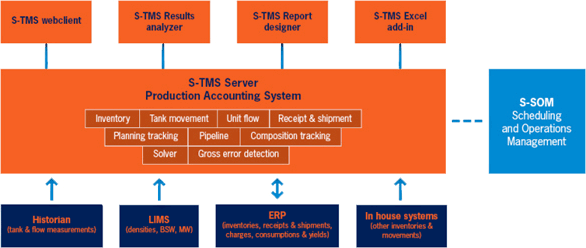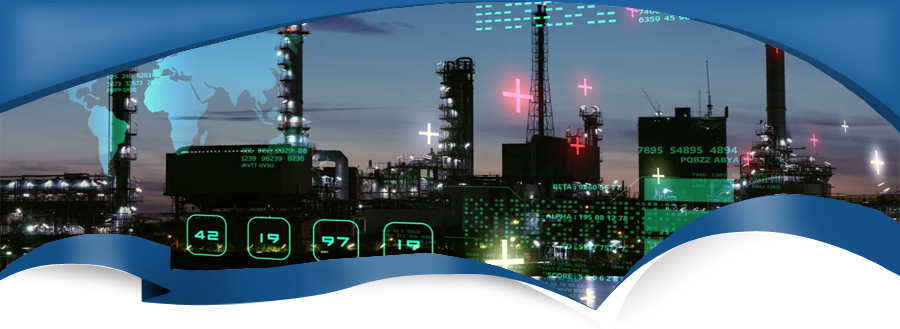SOLUTIONS > Production & Oil Accounting
Production & Oil Accounting
 EBS is the exclusive reseller of Soteica in the Middle East, a leader in production and oil movement accounting solutions.
EBS is the exclusive reseller of Soteica in the Middle East, a leader in production and oil movement accounting solutions.
S-TMS provides a complete state of the art solution for production accounting and data reconciliation which supports mass loss detection initiatives in complex industrial environments. It serves as a:
- Productivity tool for the pumpers to log their activities while providing early error detection when reporting movements and inventories.
- Data preparation tool for data reconciliation analysis.
- Central data repository where inventories and movements are calculated, distributed, traced, stored and checked using a rigorous model of the entire plant or business unit.
- Mass balance reconciliation tool.
- Gross error and mass loss detection analysis tool.
 Why S-TMS
Why S-TMS
S-TMS has been designed to support the implementation of Production Accounting / Data Reconciliation Best Practices. It is an auditable environment for the Yield Accountant to work in. In order to achieve this it has a series of capabilities that sets it apart from the rest of the software packages in the market:
- S-TMS stores the complete history of the configuration of the model. When the model changes, which is a normal situation in a plant because new meters, tanks, etc., are installed, the user can still return to the previous periods and recall the valid configurations at that moment.
- S-TMScalculates movement quantities and tolerances using all available data sources (source tank inventory differences, destination tank inventory differences, weigh scale data, meters data) and stores all of them simultaneously.
- S-TMS tracks material transfers and inventory reclassification (or regarding) even if they occur in the middle of the analysis period.
- S-TMS discounts the BSW in flow meter calculations as well as in tank calculations.
- S-TMSâ„¢s Configuration module, provides complete parameterization of the model as well as extending the objects.
- S-TMSâ„¢s Software architecture, based on configurable Plug-ins, avoids the need for ad-hoc development.
- S-TMS's user permissions assigns different access permissions for the system and for the model on a model and period status basis.
- S-TMS scheduler module schedules the execution of scripts at a given date and time (i.e.: run a report, a connector, create periods, run reconciliation, run database backups, etc.).
S-TMS Capabilities
S-TMS is an application that allows to model inventories and material movements typical of the process industry providing:

- S-TMS Results Analyzer : Advanced dynamic graphical environment for gross error and reconciliation analysis.
- Use of color coding to alert the user of errors as well as calculation status.
- S-SOLVER : embedded engine for the statistical errors minimization algorithm for mass balance reconciliation. Both the traditional gross error identification method and the successive error identification and simultaneous compensation method are available.
- S-TMS Web client, with screen forms for all data capture (both manual and from other systems).
- Inventories, flows and movement quantities calculations.
- Tracking of material changes in tanks (Reclassifications or Regradings).
- Intelligent connectors: Information import and / or export from / to other systems (Historian, LIMS, ERP, In house systems).
- Complete off-the-shelf set of standard reports.
- Report Designer, customization of existing reports and creation of new reports.
- MS Excel add-in, data retrieval into Excel spreadsheets.
- Composition tracking module, tanks composition calculation.
- Planning tracking module, Planned vs. Real  comparison.
- Pipeline tracking module, Pipeline batch tracking.
- S-SOM: operations scheduling for feedstock receptions, feedstock and product tank yard movements, pipeline operations and product shipments.
S-TMS, Focal Point of Your Loss Reduction Initiative
Sitewide Mass balance, yield accounting and data reconciliation will enable you to :
- Implement a Loss Reduction initiative at your site.
- Acquire a better and detailed knowledge of plant and tank farm operations and movements.
- Improve data quality and operating procedures.
- Detect gross errors in early stages (data entry errors, instrument failure, missing movements).
- Systematically analyze plant measurement errors and custody transfer points, which results in managing and sustaining a more focused instrumentation maintenance program.
- Have better information for Planning and ERP systems.

SOLVER
- Embedded engine for statistical errors minimization algorithm for mass balance reconciliation.
- Traditional gross error identification method and successive error identification and simultaneous compensation method are both available.
- If multiple gross errors are present in the data (most frequent case), the traditional gross error identification method will spread the error making it very difficult to detect its origin. The successive error identification and simultaneous compensation method results in a much more precise location of gross errors (leaks, instruments bias, etc.).
- Reconciliation can be run for just one period, for several individual periods at the same time or for periods of variable length.
Economics - Testimonials
During the initial months after start-up, loss of product was identified. For example we were able to identify that a buried line of Jet Fuel had a leak between the tank and the truck loading rack. A similar situation with a buried line that received shipments was identified as well. Based on these 2 cases the Refinery replaced most of the buried lines and pressure tested the rest. In addition, two tanks were identified as having wrong strapping tables with the recurrent savings generated once they were recalibrated.
Other benefits included the prioritization of the instruments that required calibration, the improved control of the receipts and shipments and that the information being generated by the accounting group is being used by all refinery personnel (unit engineers, planning group, management, etc.). With this validated information the refinery KPIs, such as energy index, volumetric expansion index, unit utilization index, etc., are being calculated. With these KPIs, the Refinery feeds a Balanced Scorecard that the Refinery use as a management tool.
"11th. ERTC Annual Meeting 13/14 November 2006".
To download a S-TMS Production Accounting System brochure in a pdf file, please click here
|
|








 EBS is the exclusive reseller of Soteica in the Middle East, a leader in production and oil movement accounting solutions.
EBS is the exclusive reseller of Soteica in the Middle East, a leader in production and oil movement accounting solutions.